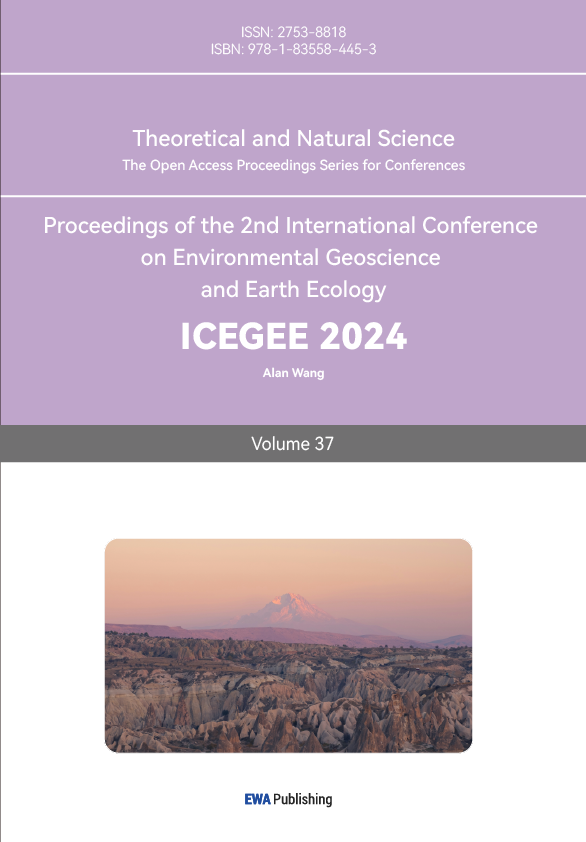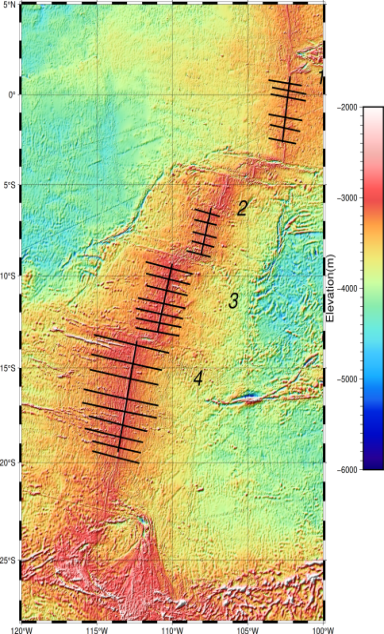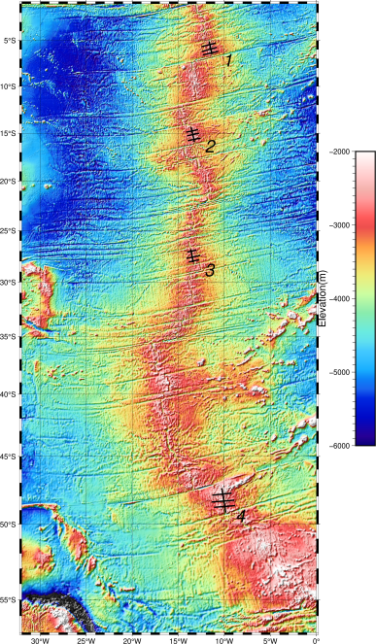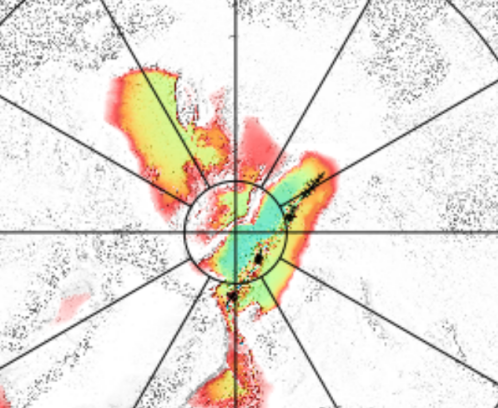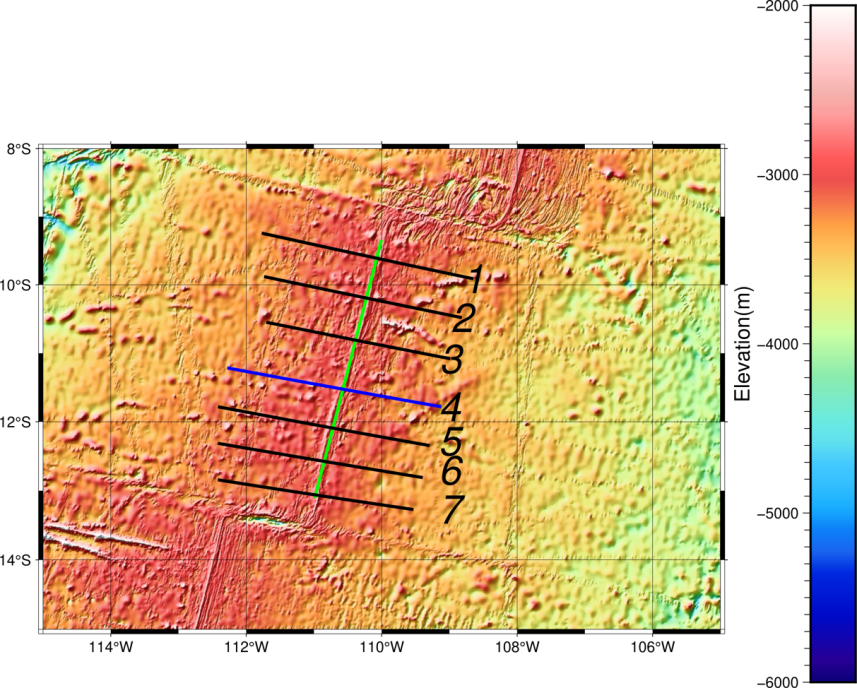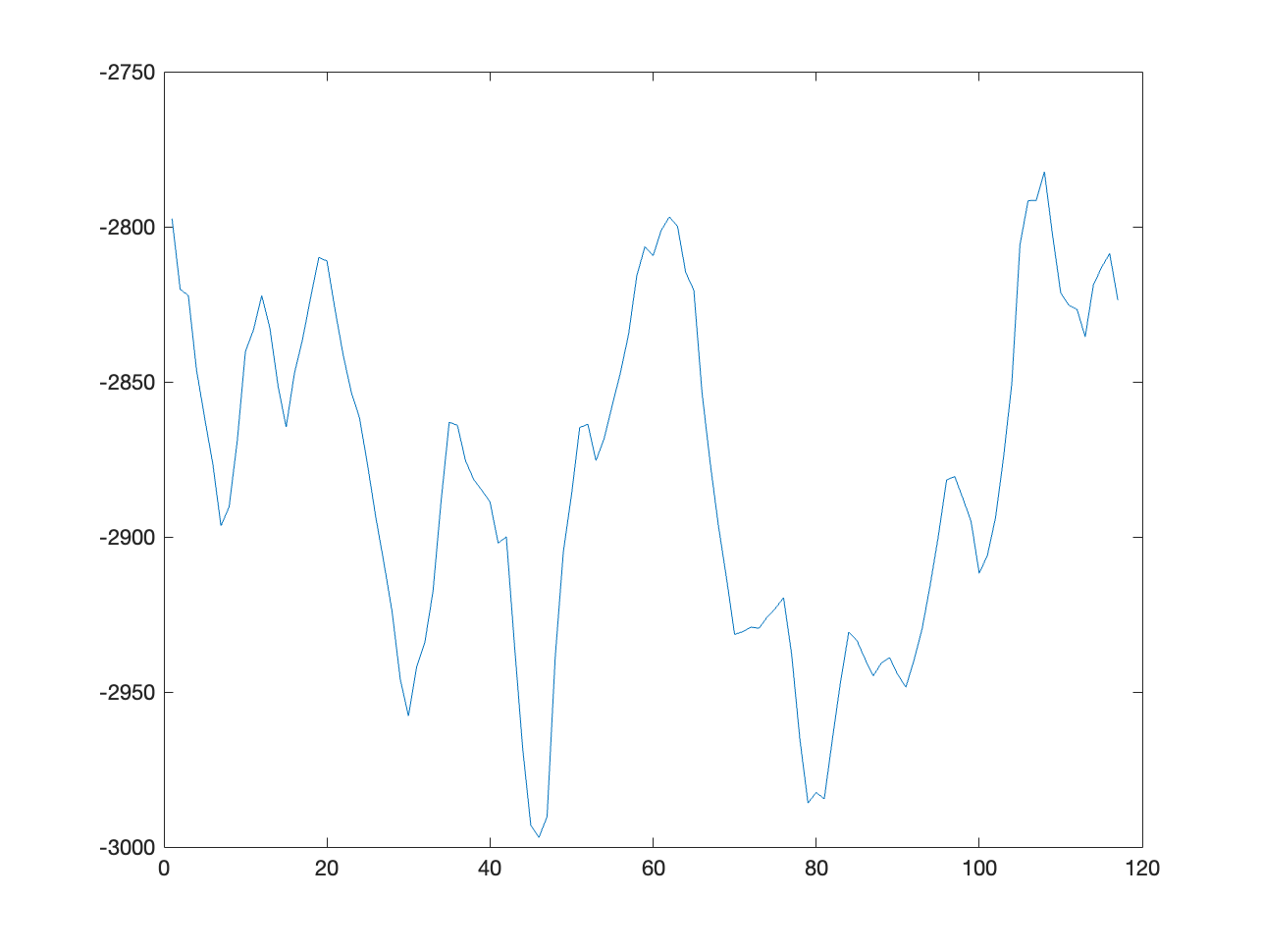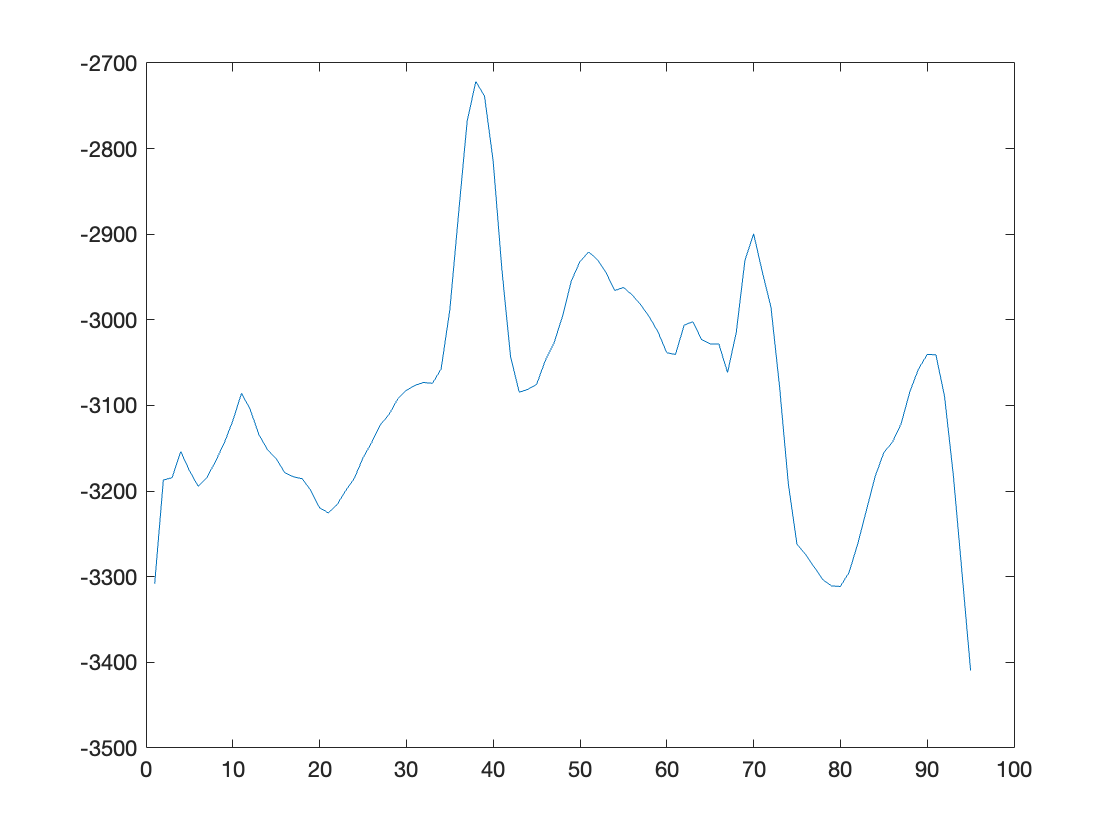1. Introduction
The ridge serves as a location where the movement of the Earth’s plates occurs, thereby impacting the Earth’s overall system. The mid-ocean ridge plays a crucial role in bolstering theory of plate tectonics, offering insights into the dynamics of the Earth’s crust in terms of its movement and formation. The quantification of axial depth enables scientists to gain a more comprehensive understanding of rate of divergence of Earth’s tectonic plates and the underlying geological configuration within the mid-ocean ridge region. Researchers are investigating the mid-ocean ridge as a means to gain insights into the Earth’s internal thermal dynamics and the convection process of the mantle [1,2].
A ridge segment is a distinct geological entity located within a mid-ocean ridge, typically comprised of one or multiple volcanic ridges. Non-transform discontinuities are features found along mid-ocean ridges that divide the ridge into segments. These discontinuities can be classified into different orders based on their characteristics [3]. These segments may vary in length, spanning from a few kilometers to several hundred kilometers. The demarcation of ridge segments is typically delineated by Transform Faults (TFs). Transform Faults (TFs), are linear valleys and transform ridges that parallel the spreading direction. The variations among ocean ridge segments primarily manifest in crustal thickness, volcanic activity, crustal composition, and seismic activity [4]. The genesis and developmental trajectory of ocean ridges are shaped by a myriad of influences, encompassing mantle convection, plate tectonics, rate of crustal accretion, and thickness of the crust. The ocean ridge serves as a critical point for investigating the internal composition and developmental trajectory of the Earth, thus holding great importance in elucidating the dynamic processes at play within the planet.
Based on variations in spreading rates and magma supply, the classifications of volcanic eruptions can be categorized into four principal types: fast, medium, slow and ultra-slow [3,5-8]. Fast spreading ridges exhibits 80-150mm/yr while the slow ones only 20-50 mm/yr. Ridges spread within the range of 20-50 are classified as medium rides. The ultra-slow spreading mid-ocean ridge is a new type defined in the global mid-ocean ridge system in recent years. As a representative of the ultra-slow spreading mid-ocean ridge, the Southwest Indian Ridge (SWIR) has the characteristics of oblique spreading, ultra-slow spreading rate, and Non-transform discontinuity (NTD) development, which has attracted great attention from the international scientific community. These non-transform discontinuities play a role in the tectonic segmentation of mid-ocean ridges and are associated with variations in sea floor depth, volcanic activity, and magma composition.
Mid-ocean ridges that spread slowly typically exhibit rift valleys. The prevailing variations of valleys entail rift axis highlands and shallow rift valleys in medium spreading ridge segment. And axial high is obvious in fast spreading ridges. Thus, the extend of axial depth reflects rate of spreading of the ocean ridge.
This paper seeks to analyze the varying rates at which mid-ocean ridges spread across different regions of the world.

Figure 1. Locations of typical mid-ocean ridges different spreading rates..
The extent of axial depth reflects rate of spreading of the ocean ridge. This parameter holds significant implications for understanding the geological composition of the mid-ocean ridge region, particularly in relation to the processes of plate divergence and crustal accretion. Consequently, axial depth may be construed as a representative indicator of plate divergence, given the mid-ocean ridge’s status as the principal locus of such activity on Earth. It is within this realm that fresh materials from the mantle ascend to occupy the rift valley, thereby contributing to the widening of the mid-ocean ridge. The axial depth may be utilized to delineate the depth of the geological structure in the vicinity of the rift axis, indicating the extent of magma supply. The alterations in the topography of the mid-ocean ridge correspond to the divergence of tectonic plates, giving rise to gradual modifications in the region’s surface features. The axial depth serves as a quantitative measure for delineating the depth of the rift axis, thereby imparting valuable insights into the topographic development of the mid-ocean ridge. The variation in depth is intimately connected with the rate at which tectonic plates are expanding. The utilization of mid-ocean ridge region as a means to signify the earth’s plate tectonics theory is of significant importance.
2. Previous work and model
The morphological features of ultraslow-, slow- and fast-spreading ridges have become the subject of continued debate within the scientific community. The evolution of mid-ocean ridge morphology occurs on time scales that are not amenable to direct observation. Therefore, researchers have developed analogue and numerical models to replicate the natural structures and to investigate the evolution of these systems. The review paper by Gerya (2012) [9] provides a comprehensive summary of these modeling approaches and associated references. Analog studies, such as the investigation conducted by Smith, have demonstrated. Previous research [10,11] has primarily focused on replicating the observed spreading patterns in natural systems, with greater challenges encountered in reproducing the overall morphology of ridges. On the contrary, numerous two-dimensional numerical investigations have concentrated on modeling the morphology of ridge cross sections. In their study, Buck et al. [1] employed simplified models featuring a central dike. In their study conducted in 2005, the researchers replicated the overall physical characteristics of fast- and slow-spreading ridges, in addition to off-axis fault structures, and demonstrated the processes underlying the formation of axial highs and valleys. Tucholke [12] utilized a comparable model. In 2008, Olive [13] conducted a study that. In 2010, a study was conducted to examine the conditions conducive to the formation of long-lived detachment faults. The aforementioned geological imperfections represent essential conditions for the formation of oceanic core complexes (OCCs). hese complexes are characterized by elevated and undulating massifs, initially noticed at the convergent points of ridge-transform intersections in regions with slow-spreading ridges. According to the findings by Cann [14], Both investigations employed spreading rates of 50 millimeters per year. The study conducted by Ito and Behn (2008) [15] prescribed the presence of a central accretion zone, which examined the transition between fast and slow spreading rates, as indicated by the various morphologies observed at intermediate spreading rates.
Perfit’s (1998) [16] investigation focuses on examining the correlation between the slope, axial depth, and spreading rate of mid-ocean ridges [17]. The distribution of magma within the central region of a swiftly propagating segment was investigated by Navin.[18] Smallwood and White analysized seismic data in order to examine the depth characteristics of the inner segment of the mid-ocean ridge [19]. In their study, utilized the GeoMapApp software in order to derive estimations of axial depth and cross-axis relief. The research conducted by Liu and Buck (2018) [20] explores the impacts of magmatic intrusions on axial geomorphology and the transition between magmatic and tectonic models. Yi and Buck (2021) [21] explores the amplitude of variations in axial depth and across-axis relief that define spreading center segmentation vary systematically with spreading rate.
Prior researchers have failed to provide quantitative measurements of the axial depth and slope of various ocean ridges. Instead, existing studies merely offer qualitative descriptions of the relationship between axial depth, slope, and spreading rate. A subset of scholars engage in studying specific, regional contexts without undertaking quantitative research on a global scale. One illustrative instance involves the work of James R. Cochran’s (2003) [22] research specifically examined the Gakkel Ridge.
3. New work on global ocean ridge
The phenomenon of ocean ridge expansion is characterized by a discernible correlation between axial depth and spreading rate. Based on the theoretical framework advanced by Liu and Buck (2018) [20], it is posited that the axial relief experiences a gradual increase in magnitude with greater distance from the central axis of the ridge. The entire tectonic model region exhibits a consistent axial terrain. In the event that a modal shift occurs within half of the ridge, adjustments to the calculation of axial crustal thickness and axial depth are necessary. Furthermore, based on the findings of the data analysis, it is apparent that the magma is not localized in the central region of the swiftly expanding ridge segment, but rather dispersed within the inner section of the ridge. The study involves the selection of ocean ridge segments with varying spreading rates and crustal thicknesses, based on analysis of seismic data. The findings indicate that axial topography and depth exhibit a consistent increase as the distance from the center of the ridge increases.
This study seeks to elucidate the relationship between axial depth, slope, and spreading rate by focusing on mid-ocean ridges characterized by significant variations in spreading rates. For the purpose of enhancing the generality and intuitiveness of the conclusion, mid-ocean ridges with varying rates of spreading were chosen. The collection of data pertaining to ocean ridge topography was conducted utilizing the GeoMapApp. The study utilized the Generic Mapping Tools to cartographically map the chosen geographic area. The provided pictures(a-d) depicts the selected sample areas and lines.
In order to investigate mid-ocean ridge dynamics with varying rates of expansion, the present study focuses on the examination of EPR, SMAR, SWIR, and GAKKEL due to their representation of distinct mid-ocean ridge types. An instance of this phenomenon can be observed in the ultra-slow spreading rate mid-ocean ridge (MOR) known as GAKKEL, as compared to the fast spreading MOR identified as EPR. The selection of MORs encompassing the world is conducted in a comprehensive manner, encompassing all varieties of MORs simultaneously.
|
| |
Figure 2. Fast spreading ridge (East Pacific Rise) | Figure 3. Locates in South Mid-Atlantic Ridge (slow spreading ridge). | |
|
| |
Figure 4. A part of Southwest Indian Ridge (ultra-slow spreading ridge). | Figure 5. The lowest spreading portion of the global mid-coean ridge system(The Gakkel Ridge). |
The primary oceanic ridge segment is chosen on a worldwide scale, and a survey line is specified along the axial and vertical orientations of the oceanic ridge segment in order to acquire elevation data. The individual calculations of the axial depth and slope are conducted for each measurement line.
The algorithm for calculating axial depth is as follows. Matlab was used for programming calculation and drawing, and the elevation data was evenly divided into 15 segments, with 5 segments on the left, middle and right.
A segment of the EPR is utilized to demonstrate the computational procedure. The figure 4 and 5 presented in this section has been chosen for further analysis.
|
Figure 6. Section of EPR and the survey line. Green line is axial line and the black lines are cross lines. |
|
Figure 7. Elevation of axial line. Data from elevation are available at http://www.geomapapp.org/. |
The figure 7 shows the elevation change on the axis. Slope is calculated as follows, Elevation and location data can be obtained from GeoMapApp. The whole segment is divided into 15 sections, with 5 segments on the left, right and middle. We define the difference of elevation as the difference between the maximum value of the middle section and the minimum value of both sides. The longitude and latitude coordinates are converted into the coordinates of the Universal Transverse Mercator Grid System (UTM), and the projected distance between two points is calculated. The slope is obtained by dividing the elevation difference by the projected distance.
|
Figure 8. Section to show the calculation method of axial depth. Locations of one segment of EPR. Elevation of line4. |
The figure 7 shows the elevation change on line 4. For a fast spreading mid-ocean ridge, the maximum value of the middle section is selected and the minimum value in the two sides of the area is offset to obtain axial depth. For slow spreading mid-ocean ridge and ultra-slow spreading mid-ocean ridge, the minimum value of the middle section is selected and the maximum value in the area on both sides is offset to obtain axial depth. The axial depth is the maximum value in the middle minus the minimum value on both sides.
4. Result and discussion
The pattern of faulting in the numerical models of axial-high related plate unbending is very sensitive to the prescribed rate and amount of weakening with strain [1]. The axial depth was determined through calculations utilizing the collected topographic data. The accompanying graph illustrates the correlation between spreading rate and axial depth.
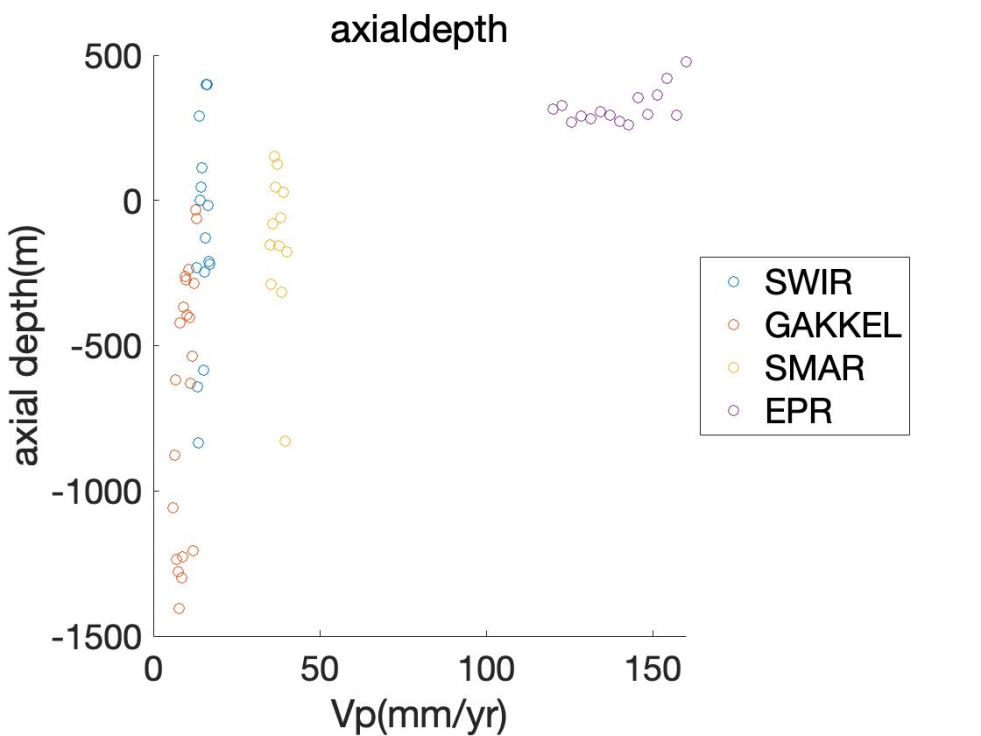
Figure 9. Correlation between spreading rate and axial depth.
As shown in the figure, the spreading rate is below 50 mm/yr, the axial depth changes dramatically, and the deep rift valley gradually transforms into a shallow rift valley as the speed increases. When the spreading rate is above 100mm/yr, axis highlands are formed. Mid-ocean ridges that spread slowly typically exhibit rift valleys that are 0.1 km in depth. The prevailing variations of valleys entail rift axis highlands and shallow rift valleys. A rift axis elevation is delineated as a narrow depression situated at the summit of the axis elevation, exhibiting a depth ranging from 50 to 200 meters and a width spanning several kilometers. Meanwhile, shallow rift valleys typically measure 2 to 4 kilometers in width and reach depths of 400 meters. The moderately extended mid-ocean ridge exhibits a distinct morphological change from the rift axis elevation to the shallow rift. The sudden shift is believed to be a threshold reaction of the mid-ocean ridge to minor fluctuations in magma supply. In instances where the supply of magma falls below a specific threshold, the rapid depletion of magma reservoirs in the Earth’s crust leads to a significant augmentation in the thickness and strength of the axial lithosphere. This, in turn, exerts influence over the characteristics of the axial topography.
It is clear that the axial depth increases as the spreading rate increases. There is a certain relationship between axial depth and spreading rate. Liu and Buck (2018) [20] demonstrate that the lithospheric dike flux is positively correlated with axial depth, indicating a potential mechanism by which magma supply may exert direct control over axial depth. The deepening of the axial valley is contingent upon the lithospheric dike opening at a rate slower than that of the plate spreading. So axial depth is positively correlated with spreading rate. This relationship has been confirmed in many studies. For example, Tolstoy [2] founds that here is a positive correlation between rate of spreading and a rate of magma supply. In the study of Purdy [23], they also found a correlation between the rate of spreading and the rate of magma supply. axial valley is a deep valley formed at the axial part of the mid-ocean ridge and is one of the most significant geomorphologic features on the mid-ocean ridge. The formation of axial valley is related to the spreading rate of mid-ocean ridge. The depth and width of the axial valley are related to the spreading rate of the mid-ocean ridge. In the region with fast spreading rate, the axial valley is shallower, while in the region with slow spreading rate, it is deeper. The depth and width of the axial valley are also related to the spreading rate of the mid-ocean ridge. The axial valley is shallower in the region with the rapid spreading rate, while the axial valley is deeper in the region with the slow spreading rate. The depth and width of the axial valley are also related to the spreading rate of the mid-ocean ridge. In regions with a faster spreading rate, the rapidly expanding mid-ocean ridge has an abundant supply of magma, so the oceanic crust there is thicker even if it is stretched out more. On the contrary, in regions with slower expansion rates, although the crust stretching is less, the magma supply rate is much slower, and the magma supply rate is not enough to compensate for the stretching and expansion, and the crust becomes thinner.
The subsequent images(a,b) demonstrate the shift in the trajectory of axis slope.
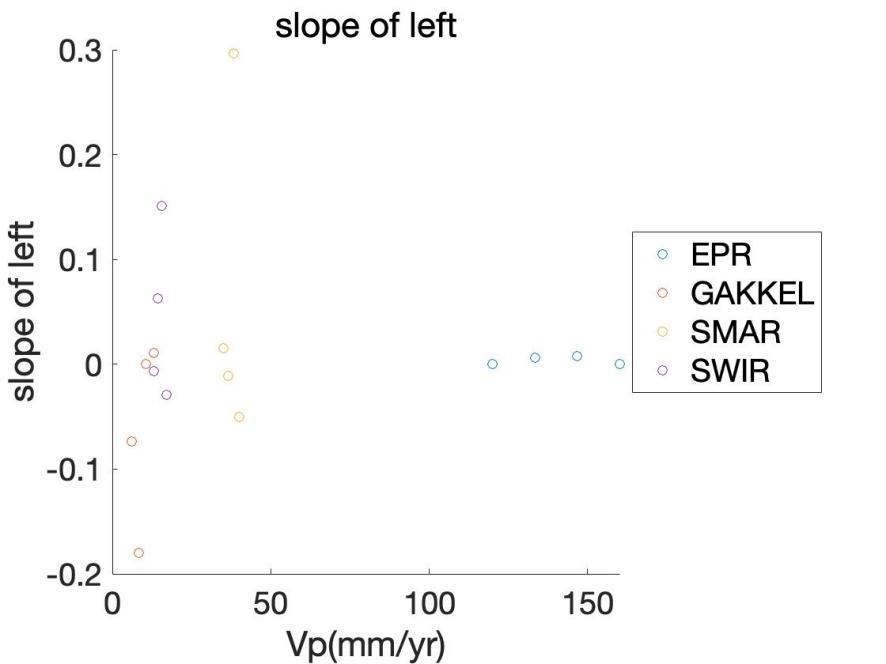
Figure 10. Axis slope between spreading rate and axial depth(left).
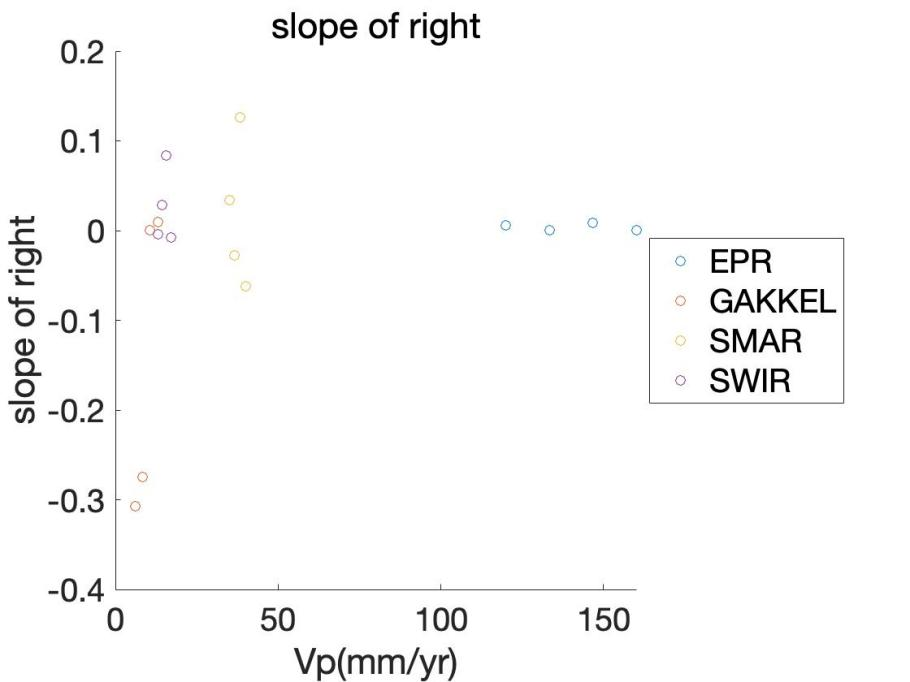
Figure 11. Axis slope between spreading rate and axial depth(right).
According to the image, there is a relationship between the slope and the rate of spreading. The main phenomenon is that the slope change in the fast expanding area is small, while the slope change in the slow expanding area is fast. In 2022, Liu and Taras Gerya [24] points out that fast spreading mid-ocean ridges have relatively constant and uniform crustal thickness, while slow and ultra-slow mid-ocean ridges exhibit more spatial variation. For fast spreading ridges, these ridges have a thermal structure and thin brittle/plastic layer that induce symmetric faults with normal oceanic ridges. In this case, the mantle potential temperature is high, resulting in a high extent of mantle melting and sufficient magma supply to crustal magma chambers. The magma supply is relatively stable, leading to a smooth and thick spreading ridge with a relatively constant slope. For slow and ultraslow spreading ridges, these ridges have cold thermal structures and thick brittle/plastic layers, which cause asymmetric detachment faults with co-existing magmatic and amagmatic segments. The influence of conductive and hydrothermal cooling is stronger at these ridges. The mantle potential temperature is low, resulting in a low extent of mantle melting and limited melt supply to crustal magma chambers. The magma supply is less stable, leading to sparse magmatic segments and three-dimensional heterogeneities along the spreading ridge. The slope variations are more pronounced in these cases. In the intermediate spreading rate region of the ridge, the pattern of the ridge axis changes from axial highs to shallow rift valleys. These changes are usually caused by changes in magma supply. When magma supply decreases below a certain threshold, magma stores in the crust rapidly disappear, resulting in a substantial increase in the thickness/strength of the axial lithosphere, which in turn controls the characteristics of the axial topography. Thus, changes in slope can reflect the characteristics and rate of spreading of ocean ridges.
5. Conclusion
The incline of the ridge axis serves as an indicator of the rate of spreading: a more pronounced incline change of the ridge axis corresponds to a slower rate of spreading of the ridge. On the contrary, stable slope inclination corresponds to a faster rate of ridge spreading. The potential relationship between the slope of the ridge axis and crustal thickness can be indicative of geological characteristics. Specifically, the slope of the ridge axis has the capacity to offer insights into the thickness of the Earth’s crust. An inverse relationship exists between the slope of a ridge axis and the thickness of the crust beneath it, with steeper slopes corresponding to thinner crust. On the other hand, as the slope decreases, there is an increase in the thickness of the crust underneath the ridge axis. The relationship between the slope of the ridge axis and the distribution of melting activity is a significant factor to consider. The variation in slope may be attributed to fluctuations in melting activity, whereby areas experiencing higher levels of melting activity are likely to exhibit steeper slopes. The stability and sufficiency of magma supply at mid-ocean ridges are influenced by the mantle potential temperature and the thermal structure of the ridge. A stable and sufficient magma supply leads to a smooth and thick spreading ridge with a relatively constant slope, while an unstable and limited magma supply results in slope variations and the formation of magmatic and amagmatic segments along the ridge.
The empirical investigation into the correlation among slope, axial depth, and spreading rate of mid-ocean ridges on a worldwide scale suggests that there is a progressive rise in axial fluctuation as the distance from the center of the segment increases in the magmatic model. The tectonic model region exhibits a persistent axial terrain. Upon comparing the observed data, it was determined that the model adequately aligns with the depth data of the inner segment of the mid-ocean ridge. The analysis of the data suggests a significant positive correlation between the effective size of the magmatic region and the spreading rate. From the analysis of the variation interval, the slow-expanding mid-ocean ridge has a large variation range, and the magma supply is small and unstable, and there are obvious differences between different segments. The magma supply in the fast-spreading ridge segment is very stable, so the slope change is also stable.
References
[1]. Buck, W.R., Lavier, L.L., Poliakov, A.N., 2005. Modes of faulting at mid-ocean ridges. Nature 434, 719–723.
[2]. Maya Tolstoy, Alistair J. Harding, and John A. Orcutt, 1993. Crustal Thickness on the Mid-Atlantic Ridge: Bull’s Eye Gravity Anomalies and Focused Accretion. 29 October 1993, Volume 262, pp. 726-729.
[3]. Carbotte S M, Smith D K, Cannat M, et al. Tectonic and magmatic segmentation of the Global Ocean Ridge System: A synthesis of observations. February 2015 Geological Society London Special Publications 420(1)
[4]. Carbotte S M, Rift topography linked to magmatism at the intermediate spreading Juan de Fuca Ridge. Geology (2006) 34 (3): 209–212.
[5]. Macdonald K C, Fox P J. 1988. A new view of the mid-ocean ridge from the behavior of ridge axis discontinuities. Nature, 335: 217–225.
[6]. Macdonald, K.C. , Mid-oceanic ridge, in Parker, S.P., ed., McGraw-Hill Yearbook of Science & Technology, McGraw-Hill, Inc., New York, 259-262, 1992.
[7]. John Lin, G. M. Purdy, H. Schouten, J.-C. Sempere and C. Zervas. Evidence from gravity data for focusedmagmatic accretionalong the Mid-Atlantic Ridge. Nature volume 344, pages 627–632 (1990)
[8]. Henry J. B. Dick, Jian Lin & Hans Schouten. An ultraslow-spreading class of ocean ridge. December 2003Nature 426(6965):405-12
[9]. Taras Gerya, Origin and models of oceanic transform faults. February 2012Tectonophysics 522
[10]. Douglas W. Oldenburg, James N. Brune. An explanation for the orthogonality of ocean ridges and transform faults. Volume80, Issue17 Solid Earth and Planets 10 June 1975 Pages 2575-2585
[11]. Olivier Dauteuil. Lithosphere strength controls oceanic transform zone structure: Insights from analogue models. September 2002Geophysical Journal International 150(3):706-714
[12]. Brian E. Tucholke, Ross Parnell-Turner, Deborah K. Smith. The Global Spectrum of Seafloor Morphology on Mid-Ocean Ridge Flanks Related to Magma Supply. Volume128, Issue12 December 2023 e2023JB027367
[13]. Jean-Arthur Olive. Controls on the magmatic fraction of extension at mid-ocean ridges. Earth and Planetary Science Letters Volume 549, 1 November 2020, 116541
[14]. J. R. Cann, D. K. Blackman, D. K. Smith, E. McAllister, B. Janssen, S. Mello, E. Avgerinos, A. R. Pascoe and J. Escartin. Corrugated slip surfaces formed at ridge–transform intersections on the Mid-Atlantic Ridge. Nature volume 385, pages 329–332 (1997)
[15]. Garrett Ito, Mark D. Behn. Magmatic and tectonic extension at mid-ocean ridges: 2. Origin of axial morphology. Geochemistry, Geophysics,Geosystems Volume9, Issue9 September 2008
[16]. Perfit, Michael R. ; Chadwick, William W., Jr. Magmatism at mid-ocean ridges: Constraints from volcanological and geochemical investigations. Faulting and Magmatism at Mid-Ocean Ridges. (1998), Geophys. Monogr. Ser., vol. 106, edited by W. Roger Buck et al., pp. 59-115, AGU, Washington, D. C.
[17]. R. S. Detrick, A. J. Harding, G. M. Kent, J. A. Orcutt, J. C. Mutter, AND P. Buhl. Seismic Structure of the Southern East Pacific Rise. SCIENCE 22 Jan 1993 Vol 259, Issue 5094 pp. 499-503
[18]. D. A. Navin, C. Peirce, M.C. Sinha. The RAMESSES experiment—II. Evidence for accumulated melt beneath a slow spreading ridge from wide-angle refraction and multichannel reflection seismic profiles. Geophysical Journal International, Volume 135, Issue 3, December 1998, Pages 746–772
[19]. John R. Smallwood, Robert S. White. Crustal accretion at the Reykjanes Ridge, 61°–62°N. Volume103, IssueB3 10 March 1998 Pages 5185-5201
[20]. Zhonglan Liu, W. Roger Buck, 2018. Magmatic controls on axial relief and faulting at mid-ocean ridges. Earth and Planetary Science Letters 491 (2018) 226–237.
[21]. Yi Luo, W. Roger Buck, 2021. Magma source region size controls along axis variations in crustal thickness, axial depth and relief at plate spreading centers. Earth and Planetary Science Letters Volume 575, 1 December 2021, 117192.
[22]. James R. Cochran, Gregory J. Kurras, Margo H. Edwards, Bernard J. Coakley. The Gakkel Ridge: Bathymetry, gravity anomalies, and crustal accretion at extremely slow spreading rates. Volume108, IssueB2 February 2003
[23]. G. M. Purdy, L. S. L. Kong, G. L. Christeson & S. C. Solomon. Relationship between spreading rate and the seismic structure of mid-ocean ridges. Nature volume 355, pages 815–817 (1992)
[24]. Mingqi Liu, Taras Gerya. Forced Subduction Initiation Near Spreading Centers: Effects of Brittle-Ductile Damage. JGR Solid Earth Volume128, Issue2 February 2023 e2022JB024701
Cite this article
Peng,J. (2024). Morphological characteristics and relationship with spreading rates in Mid-Ocean ridges. Theoretical and Natural Science,37,248-257.
Data availability
The datasets used and/or analyzed during the current study will be available from the authors upon reasonable request.
Disclaimer/Publisher's Note
The statements, opinions and data contained in all publications are solely those of the individual author(s) and contributor(s) and not of EWA Publishing and/or the editor(s). EWA Publishing and/or the editor(s) disclaim responsibility for any injury to people or property resulting from any ideas, methods, instructions or products referred to in the content.
About volume
Volume title: Proceedings of the 2nd International Conference on Environmental Geoscience and Earth Ecology
© 2024 by the author(s). Licensee EWA Publishing, Oxford, UK. This article is an open access article distributed under the terms and
conditions of the Creative Commons Attribution (CC BY) license. Authors who
publish this series agree to the following terms:
1. Authors retain copyright and grant the series right of first publication with the work simultaneously licensed under a Creative Commons
Attribution License that allows others to share the work with an acknowledgment of the work's authorship and initial publication in this
series.
2. Authors are able to enter into separate, additional contractual arrangements for the non-exclusive distribution of the series's published
version of the work (e.g., post it to an institutional repository or publish it in a book), with an acknowledgment of its initial
publication in this series.
3. Authors are permitted and encouraged to post their work online (e.g., in institutional repositories or on their website) prior to and
during the submission process, as it can lead to productive exchanges, as well as earlier and greater citation of published work (See
Open access policy for details).
References
[1]. Buck, W.R., Lavier, L.L., Poliakov, A.N., 2005. Modes of faulting at mid-ocean ridges. Nature 434, 719–723.
[2]. Maya Tolstoy, Alistair J. Harding, and John A. Orcutt, 1993. Crustal Thickness on the Mid-Atlantic Ridge: Bull’s Eye Gravity Anomalies and Focused Accretion. 29 October 1993, Volume 262, pp. 726-729.
[3]. Carbotte S M, Smith D K, Cannat M, et al. Tectonic and magmatic segmentation of the Global Ocean Ridge System: A synthesis of observations. February 2015 Geological Society London Special Publications 420(1)
[4]. Carbotte S M, Rift topography linked to magmatism at the intermediate spreading Juan de Fuca Ridge. Geology (2006) 34 (3): 209–212.
[5]. Macdonald K C, Fox P J. 1988. A new view of the mid-ocean ridge from the behavior of ridge axis discontinuities. Nature, 335: 217–225.
[6]. Macdonald, K.C. , Mid-oceanic ridge, in Parker, S.P., ed., McGraw-Hill Yearbook of Science & Technology, McGraw-Hill, Inc., New York, 259-262, 1992.
[7]. John Lin, G. M. Purdy, H. Schouten, J.-C. Sempere and C. Zervas. Evidence from gravity data for focusedmagmatic accretionalong the Mid-Atlantic Ridge. Nature volume 344, pages 627–632 (1990)
[8]. Henry J. B. Dick, Jian Lin & Hans Schouten. An ultraslow-spreading class of ocean ridge. December 2003Nature 426(6965):405-12
[9]. Taras Gerya, Origin and models of oceanic transform faults. February 2012Tectonophysics 522
[10]. Douglas W. Oldenburg, James N. Brune. An explanation for the orthogonality of ocean ridges and transform faults. Volume80, Issue17 Solid Earth and Planets 10 June 1975 Pages 2575-2585
[11]. Olivier Dauteuil. Lithosphere strength controls oceanic transform zone structure: Insights from analogue models. September 2002Geophysical Journal International 150(3):706-714
[12]. Brian E. Tucholke, Ross Parnell-Turner, Deborah K. Smith. The Global Spectrum of Seafloor Morphology on Mid-Ocean Ridge Flanks Related to Magma Supply. Volume128, Issue12 December 2023 e2023JB027367
[13]. Jean-Arthur Olive. Controls on the magmatic fraction of extension at mid-ocean ridges. Earth and Planetary Science Letters Volume 549, 1 November 2020, 116541
[14]. J. R. Cann, D. K. Blackman, D. K. Smith, E. McAllister, B. Janssen, S. Mello, E. Avgerinos, A. R. Pascoe and J. Escartin. Corrugated slip surfaces formed at ridge–transform intersections on the Mid-Atlantic Ridge. Nature volume 385, pages 329–332 (1997)
[15]. Garrett Ito, Mark D. Behn. Magmatic and tectonic extension at mid-ocean ridges: 2. Origin of axial morphology. Geochemistry, Geophysics,Geosystems Volume9, Issue9 September 2008
[16]. Perfit, Michael R. ; Chadwick, William W., Jr. Magmatism at mid-ocean ridges: Constraints from volcanological and geochemical investigations. Faulting and Magmatism at Mid-Ocean Ridges. (1998), Geophys. Monogr. Ser., vol. 106, edited by W. Roger Buck et al., pp. 59-115, AGU, Washington, D. C.
[17]. R. S. Detrick, A. J. Harding, G. M. Kent, J. A. Orcutt, J. C. Mutter, AND P. Buhl. Seismic Structure of the Southern East Pacific Rise. SCIENCE 22 Jan 1993 Vol 259, Issue 5094 pp. 499-503
[18]. D. A. Navin, C. Peirce, M.C. Sinha. The RAMESSES experiment—II. Evidence for accumulated melt beneath a slow spreading ridge from wide-angle refraction and multichannel reflection seismic profiles. Geophysical Journal International, Volume 135, Issue 3, December 1998, Pages 746–772
[19]. John R. Smallwood, Robert S. White. Crustal accretion at the Reykjanes Ridge, 61°–62°N. Volume103, IssueB3 10 March 1998 Pages 5185-5201
[20]. Zhonglan Liu, W. Roger Buck, 2018. Magmatic controls on axial relief and faulting at mid-ocean ridges. Earth and Planetary Science Letters 491 (2018) 226–237.
[21]. Yi Luo, W. Roger Buck, 2021. Magma source region size controls along axis variations in crustal thickness, axial depth and relief at plate spreading centers. Earth and Planetary Science Letters Volume 575, 1 December 2021, 117192.
[22]. James R. Cochran, Gregory J. Kurras, Margo H. Edwards, Bernard J. Coakley. The Gakkel Ridge: Bathymetry, gravity anomalies, and crustal accretion at extremely slow spreading rates. Volume108, IssueB2 February 2003
[23]. G. M. Purdy, L. S. L. Kong, G. L. Christeson & S. C. Solomon. Relationship between spreading rate and the seismic structure of mid-ocean ridges. Nature volume 355, pages 815–817 (1992)
[24]. Mingqi Liu, Taras Gerya. Forced Subduction Initiation Near Spreading Centers: Effects of Brittle-Ductile Damage. JGR Solid Earth Volume128, Issue2 February 2023 e2022JB024701





